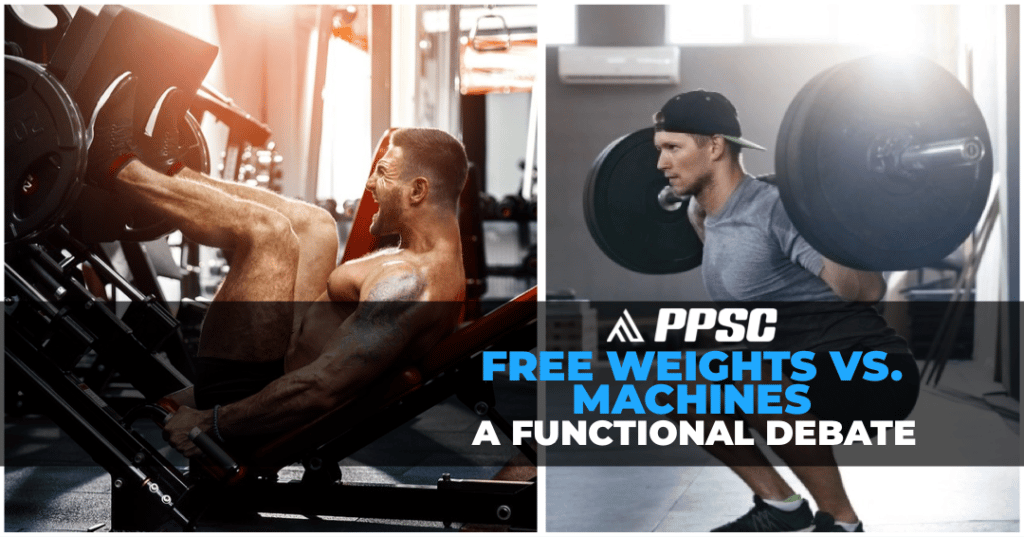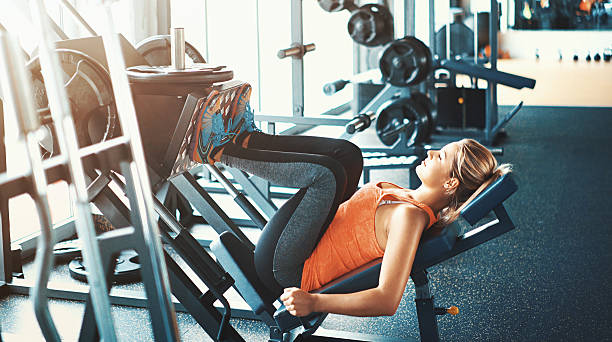As it seems to be with most things in the modern era, the debate amongst fitness professionals regarding the most effective training tools is a polarizing trough of unchecked bias.
This is especially true with the free weights vs. machines argument. Ironically, like most hot-button topics, most fitness professionals (who train people in person) lie somewhere in between the noisy extremes and will use whatever tool is best for their client.
Still though, the individuals at either end of the spectrum voice their opinions ardently enough that an exploration of the poles is warranted, and probably necessary, for the betterment of all. With most fitness facilities possessing a combination of free weights and selectorized machines for resistance training – the conversation is pertinent to private trainers, small businesses, and big box facilities alike.
Ultimately, understanding the value of both free weights and machines in a training program is the cornerstone to the construction of a healthy, and inclusive, fitness business. More importantly, seeing any exercise tool through the eyes of the prospective, or paying, client is more valuable than any dogmatic belief could ever be (if you’d like to be successful).
What is Really Being Argued:
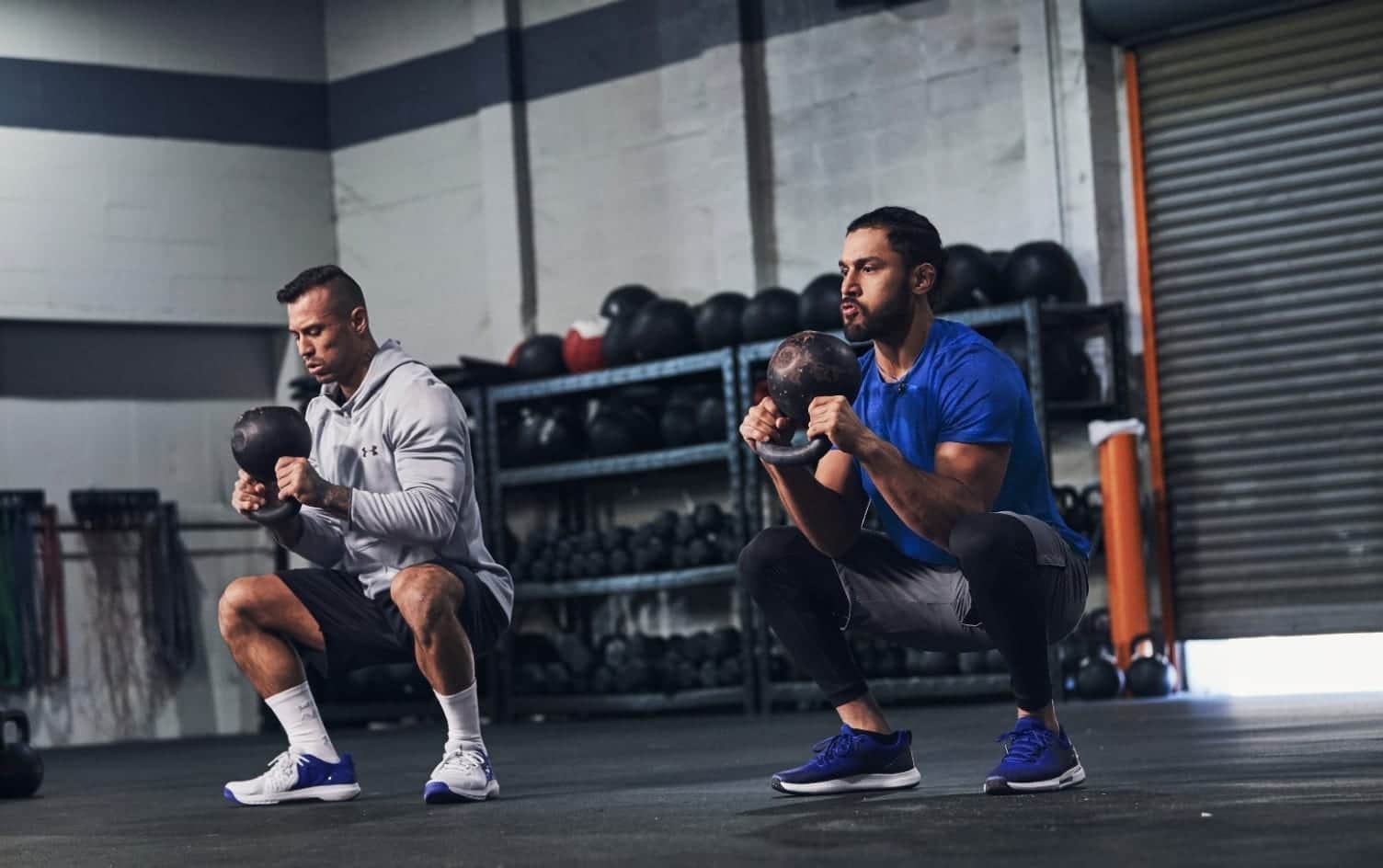
Underneath any argument lies foundational issues, or topics, that become represented by the “thing” being argued. For a married couple, the uncleaned dishes in the sink spark an argument, but the underlying issue is the routine carelessness of one spouse regarding housekeeping duties. For progress to be made it is imperative to find what is “actually being argued” instead of investing time and energy into the symbols of a larger, systemic problem.
Shifting back to the “free weights vs. machines” with this mindset reveals the real debate:
Movement-Emphasis Training vs. Muscle-Emphasis Training
Or
Functional Training vs. Bodybuilding
Ultimately, the fitness industry has split into two distinct camps that locked head-to-head like wild rams. One side states that every exercise should relate to real life and sport in a clear and obvious way. This methodology, typically referred to as “functional training” prioritizes compound movement patterns throughout all three movement planes with a variety of loading protocols.
The other side, “muscle-based” training is built upon the premise that hypertrophy, and strength development, requires an overload principle to be applied to the muscle, regardless of the modality used to get there. Partial ranges of motion, specialized equipment, and fatigue-inducing programming are utilized to stress tissue to the point of adaptation.

Functional trainers find biceps curls and chest press machines to be a waste of time and a poor use of a person’s training capacity, especially during paid session. The idea of filling their gym with machines is expensive and wasteful when they could just find a more dynamic way of training a movement pattern.
They often think, “sure you like The Rock, but you move like one too.”
Muscle and Performance-minded trainers ignore the lateral kettlebell swings and windmills and laugh at the idea of mobilizing the big toe. They see any exercise that doesn’t translate into a clear hypertrophy or rate-of-force-development measurable as a waste of time and a person’s training capacity, especially during a paid session.
They often think, “Sure, you are actually super fit, but you don’t look like it.”
The funny thing about this paradigm is that neither side of the debate is wrong, nor are they right. They are simply viewing the same problem through different lenses. Functional trainers see fitness as an exploration of dynamic and complete movements that expose the bones, muscles, and fascial systems to a variety of loads, positions, and velocities.
And yet, many clients who are trained in this manner are often a bit displeased with their results as it pertains to their aesthetic and performances. Surely, their training emphasized skill acquisition, movement mastery, and a “balanced” body optimized to live life. But they often miss out on the overload stimulus necessary to induce hypertrophy, or the loading schemas needed to boost strength and power.
Meanwhile, muscle-based trainers see fitness as a journey to see just how much muscle, strength, and performance can be developed by training the same movements through controlled ranges of motions with systemized loads and velocities over time.
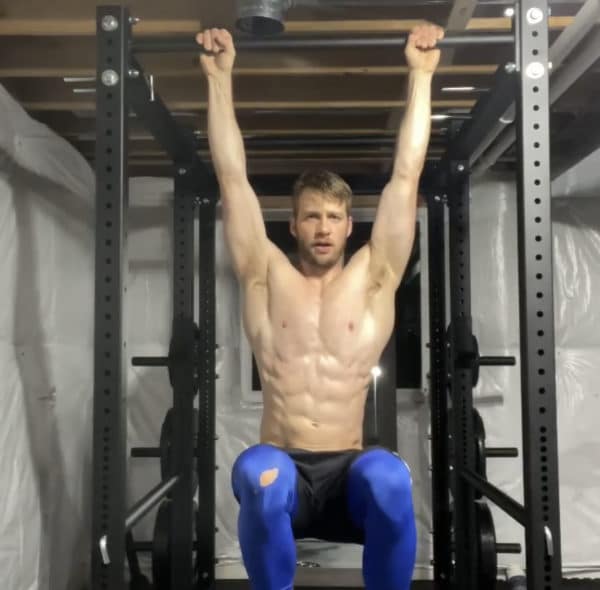
And yet, many clients who are trained with this approach are often displeased with their results. Surely, they’ve developed more muscle, moved more weight, and may have seen some dramatic changes in their body composition. However, they’ve sacrificed quality movement, the health of joints, and pain-free living to maximize the appearance of fitness. They’ve missed out on individualized movements patterns, appropriate correctives, and dynamic warmups that optimize their training.
All of this is to say that the best position in this debate, like most, is closer to the center. The most successful fitness professionals are those who understand the value of functional training for developing a client’s movement capacities, creating synergistic movement patterns across distant joints, and preparing the body for stress in positions that can be encountered in real life.
Still, those same trainers understand that the best training programs also shift their client’s body towards better body composition, greater muscle mass, and improved force output.
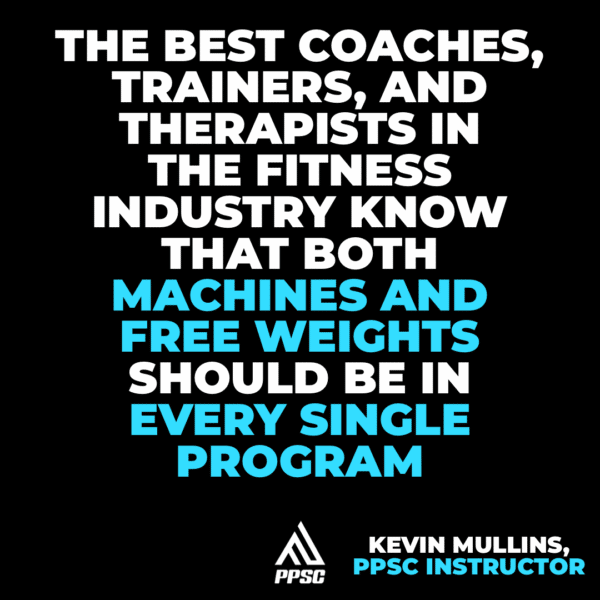
The Case for Machine Training:

When looking at resistance training machines it is important to understand that not all machines are created equally. There are a variety of training methods that technically count as machine training:
Selectorized Machines

The most common resistance-based training machine that comes to mind. These machines are designed to accommodate individuals between 5’5 and 6’2 (ish) through seat and lever adjustments. The load is pre-built into a stack and is selected by placing a pin or turning a toggle. By in large, these movements offer little variability in training effect. They are quite literally, “sit down, select your weight, and get to pumping”.
Plate Loaded Machines

The second most common resistance-based machine in fitness. These body-part specific machines often have a variety of hand positions or foot positions available to provide options to the trainee. Weight is selected by adding or subtracting plates from the pegs. Subtle adjustments to seat heights and angles are often provided to manipulate the angle in which force is placed upon the body. These machines provide limited variability in training effect but do provide the opportunity for accommodating resistance.
Free Standing Cable Machines

Another common training modality, the open-floor cable stacks provide a large range of exercise options, angles, and loading parameters. These units utilize stack weights with pins or toggles for weight selection (like selectorized machines). They truly shine when looking at the ability to adjust the height and width of a given movement. Within a training platform, these machines are very “functional”.
Specialty Machines

The least common machine in the industry is often found in gyms that specialize in specific training outcomes. K-boxes, Pit Sharks, Reverse Hyperextensions, and multi-angle chest presses are examples of these devices. Their place in a training program is usually quite specific and individuals utilizing them are doing so intentionally or by the intentional guidance of their coach.
*Accommodating Resistance
The use of bands/chains to manipulate the force-vector profile of a lift by intensifying the more lengthened positions.
This examination demonstrates that machines are more than just “sit and lift” as many dogmatic functional fitness professionals might proclaim. In fact, ignorance of the major advancements in resistance training machines is willful now and in no way negligent. Machines clearly have a place in every training program – regardless of the client’s goals.
Still, machines can’t be relied on as the sole source of training stimuli for clients. The fixed positions and minimally dynamic loading profiles don’t allow for peak functional performance.
The Top 5 Reasons to Use Machines in Your Programs
1) Muscle Awareness
So many clients have no idea what their latissimus dorsi are. They heard Tyrannosaurus Rex when you said it. Instead of force feeding a free-weight row to your clients, utilize a machine (like the seated cable row) to groove the mind-muscle-movement connection.
2) Phase 5 Preparation
Phase 5 of the Dynamic Warmup is about preparing the body for the specific training stimuli that are about to be encountered. A machine provides an amazing opportunity to gradually increase load, set-by-set, during a warmup phase so that the client is more ready to take on a heavier training load.
Check out more on Phase 5 here
3) Super Set Strategies
Take your favorite free weight exercise and pair with a machine for an overload stimulus for the ages. For example, a set of Goblet Squats taken to near fatigue followed by a set of Hack Squats or Leg Presses to failure will accomplish functional and muscular goals.
4) End-Program Muscle Fatigue
Congratulations, you did the thing. You pressed and twisted, carried, and hinged; functionality for everyone, hooray. Everyone knows their big toe, piriformis, and spiral sling exists. Now, let’s smoke out a few muscles and get that sweet pump that Arnold talked about many years ago. Use machines to simplify the task and dominate the goal.
5) Injury Recovery
In early phase injury recovery, some clients are not able to adequately perform movement patterns due to weakness in muscles that atrophied as a result of the injury or repair. Machines provide a controlled environment to reintroduce stress to their body without risk of compensatory movements that could lead to worsened recovery or other problems.
Check out the best rehab exercises and how to use them here
It’s clear when viewing this list through clear and open eyes that machines possess tremendous potential in a training program. To completely ignore them, or downplay them, is to be more satisfied by dogmatic ego-stroking than it is to be an honest, caring, and effective trainer.
Machines belong in training programs.
The Case for Free Weight Training

Honestly, this is a funny section to write. The reasons someone should use free weights are well-known, even amongst those who aren’t regular gym goers. Even the least active person who thinks it’s spelled “Fitness Jim” knows that lifting weight does cool shit to your body.
But, for the purposes of an intellectually appropriate and fully developed article, this section will aim to provide greater diversity to the ideas surrounding free-weight training. In the end, the takeaway is that free weights are a necessary aspect of training.
When examining “free weights” it is important to look at all the possible ways that the body can be externally loaded with a tool.
1) Barbells (Locked Training)

Barbells are incredible tools for training compound movements such as the deadlift, bench press, and lunge with appreciable weight. A barbell locks the hands and arms together to unify the two sides of the body and promote optimal force production in the (hopefully) absence of rotational and lateral flexion forces. This category also includes specialty bars such as the SS Yoke Bar, Bamboo Bars, Duffalo Bars, Water-filled PVCs, and any other bilateral tool.
2) Dumbbells (Unlocked Training)

Dumbbells are the most utilized tool for fitness training in the world. With each hand holding its own dumbbell, each side of the body is responsible for managing rotation and lateral flexion while also working in coordination for a bilateral, unilateral, contralateral, or ipsilateral movement. They can move at the same, alternated, reciprocated, and isolated. Every movement is trainable with dumbbells.
3) Kettlebells (Unlocked, Offset Training)

Kettlebells are one of the oldest tools for training. The load position in relation to the handle provides unique loading parameters that promote unilateral training. Kettlebells can be utilized like dumbbells in some scenarios, but shine when moved through patterned preferential to the bells design. Swings, Cleans, Snatches, Halos, Windmills, and Turkish Get Ups are examples.
4) Specialty Tools (Dynamic, Offset Training)

Indian Clubs, Maces, Medicine Balls, and Battle Ropes provide unique training stimuli in a variety of angles, velocities, and loading profiles that are specific to the tools. Maces are amazing for spiral sling and oblique training whereas Medicine Balls can be incredible tools for isometric squeezes and high velocity throws/slams. Indian Clubs are incredible for rotator cuffs whereas battle Ropes can influence hypertrophy in the arms when used like a resistance and not a conditioning tool.
Check out our article on Mace training here
5) Bodyweight (Dynamic Unloaded Training)

Technically, bodyweight training is a free-weight exercise since there are no limitations or structures keeping the body in a specific position. An often-overlooked element of muscle-building training, this modality has the potential to serve as the direct link between function and performance.
Even free weights aren’t created equal. Knowing this allows us to better program free weight exercises into a client’s protocol. Acknowledging that we can load the body for sagittal performance, angle-specific muscle breakdown, transverse plane force development, or multi-planar movement fluidity is critical to being the best trainer one can be.
The Top 5 Reasons to Use Free Weights in a Program
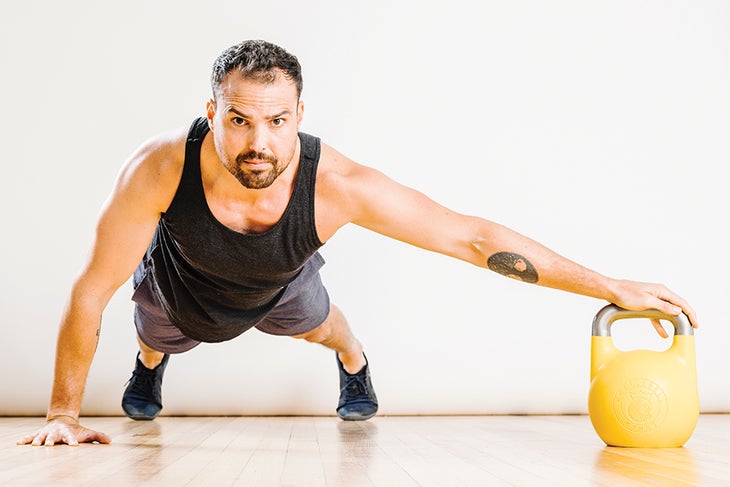
1) Force Development in the Sagittal Plane
regardless of what tool is used, free weights allow for a person to load up a squat, deadlift, push, or pull and get after it. Barbell exercises have been putting muscle and improving strength on millions of individuals for well over a century.
2) Angle-Specific Muscle Training
With dumbbells specifically, a trainee can train certain muscles in a manner that promotes optimal growth and development. Bodybuilders and physique competitors utilize specific angles and partial ranges of motion to overload a muscle in a position that leads to noticeable hypertrophy.
3) Sports-Specific Force Profiles
Utilizing medicine ball lateral throws can improve a pitcher’s velocity on the pound. Kettlebell swings and depth jumps can improve a volleyball player’s vertical. Put simply, machines don’t adequately prepare the human body for sports, especially as it pertains to velocity production and reduction.
4) Movement Mastery
while machines can serve as a cheat code for working muscles with the intent for strength and hypertrophy; they don’t contribute to mastery of the essential human movement patterns. Gyms everywhere are unfortunately littered with leg press beasts who regularly use all the plates in the area code but couldn’t squat their bodyweight if you paid them. Free-weights allow for the trainee to get damn good at moving their body in specific orientations with stability, sequencing, and smoothness.
5) Return-to-Play Loading
For athletes and gym goers who have graduated from a rehab programming, the reintroduction to loaded, unsupported movement is a critical part of their journey back to healthy. Free weights, especially kettlebells and specialty tools can improve fascial efficacy and build muscular strength, endurance, and size.
It didn’t take much convincing, but as you can see, free weights are essential elements of any training program. They can be, and should be, the foundation and backbone of the training programs we design for our clients.
*On Weight/Fat Loss – The benefit of improving a clients Basal Metabolic Rate (and thus improving their chances of burning fat as fuel and changing their body composition) was not discussed in either section because both methods can contribute to this outcome.
The Business Implications of a Dogmatic Approach
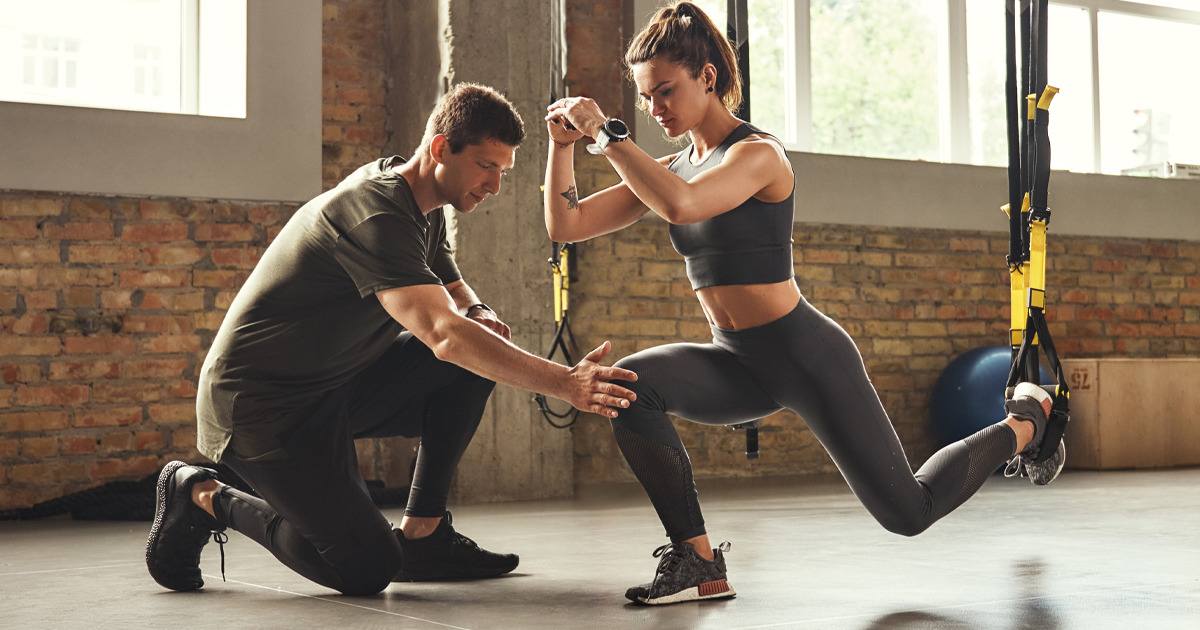
It is important to step out of the science in this article for at least one section. Each fitness professional is running a business. Some sell their own performance on social media while others spend 16 hours in a facility per day training clients back-to-back. Regardless of how the cash is made – the fact of the matter is that businesses who are dogmatic tend to follow the same exact growth (and loss curve).
First 6 months to 1 year
Loud, dogmatic approaches catch the attention of the market. The brazen commentary and competition presented by the business intrigues customers in the same way a person’s confidence in a bar draws the attention of the single and interested. Everyone likes a confident “answer” to their problems.
1 year to 2 years
The dogmatic approach has lost its luster, clients drop off from boredom, redundancy, and a lack of results that they paid for. They may have experienced tremendous growth in some areas, but still didn’t get what “THEY” paid for. The business leaks clients/members and doubles down on their messaging. Ego-boosting sentiments such as “I don’t want people who don’t believe in what I believe in” further segregates them from the gross market that generally wants to trade cash for fitness.
2 years and Beyond
Slowly the business disintegrates under the weight of its dogma. The branding that once looked sexier than Ryan Gosling holding a puppy is now repulsive, non-inclusive, and tone deaf. The professional must move on.
*The inevitable exception – Surely there are dogmatic brands that have thrived to some degree. Westside barbell is a perfect example. However, they can be so dogmatic and specific for 1 distinct reason:

Louie Simmons and his team are the absolute best in the game at developing elite level powerlifters. The amount of 1,000-pound lifters that have emerged from that facility is mind-numbing.
And thus, if you are going to dogmatic and specific in your market, then you better be the absolute best.
A business must consider that their success relies on the ability to serve a broad range of individuals who come to fitness from various positions in their life. A brand can be dogmatic about their passions and ideals, such as “don’t stop a rep short if your form is still in check” or “Being late is unacceptable”, but never about their training methodology.
There are different strokes for different folks. Just look at a dating app, for example. Everyone on there is looking for something different, and yet the same. Everyone wants someone attractive, driven, smart, nice, etc. And yet, that looks different for everyone who logs in.4
The same goes for your fitness clientele. They all want to be leaner, more muscular, pain-free, athletic, and generally awesome. However, the road to such achievement might look different and require a variety of methods and interventions to get to the destination.
The Final Verdict
Put simply, all training programs should feature free weights and machines. All training programs should feature functional and muscle-based modalities. All trainers should embrace an “AND” mindset and not a “BUT” mindset.
So, the next time someone says, “Should I use dumbbells or machines?” the only answer should be, “You should use dumbbells and machines”.
Pain-Free Performance requires training that lacks dogma, bias, and blind spots. It requires a commitment to the benefit of the client and complete ignorance of one’s own preferences.

